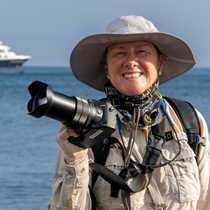Known as the "Little Norway" of Alaska, Petersburg has a high population of Scandinavians whose chief occupations are fishing, canning, lumbering and fur farming. The town grew up around a salmon cannery and sawmill built in 1897-99 by Peter Buschmann, after whom it was named. The first Post Office opened in 1900.
Our beautiful weather from yesterday had disappeared, but despite a bit of an overcast and light sprinkle of rain, several of our guests chose to go flightseeing over LeConte glacier to the south. They got a splendid aerial view of blue ice, the monstrous and magnificent glacier, and mother-calf seal pairs on the ice floes near the face of the glacier.
Others went on a long and rigorous hike outside of town through the moist temperate rainforest of the Pacific Northwest, while still another group chose to visit a muskeg (Alaskan bog) by boardwalk. A fascinating place, these muskegs contain vegetation which can survive in this extremely acidic environment. An example would be sphagnum moss, used for a million and ones things, but known for it's antiseptic ability and therefore used as packing for wounds during the First World War. Even today, those who know and are injured out in the wilds, far from medical help, use this knowledge to their advantage. Known as the "Little Norway" of Alaska, Petersburg has a high population of Scandinavians whose chief occupations are fishing, canning, lumbering and fur farming. The town grew up around a salmon cannery and sawmill built in 1897-99 by Peter Buschmann, after whom it was named. The first Post Office opened in 1900.
Many spent the afternoon wandering the town of Petersburg, while others took a Zodiac ride across the Narrows to Kupreanof Island and hiked once more through forest, over bog and hill, experiencing to the last a day most typical of southeast Alaska.




